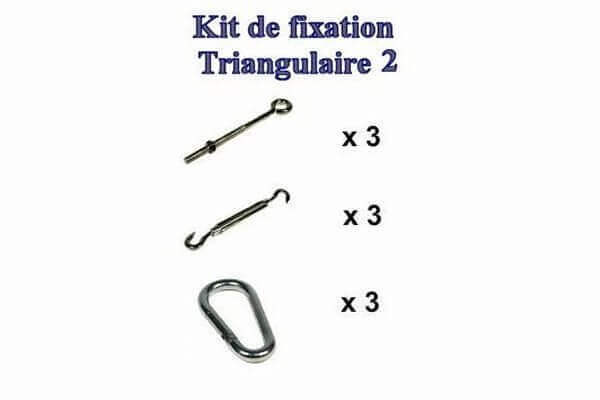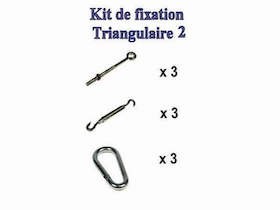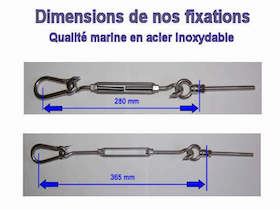Why use marine grade fixings for shade sails
Using marine-grade fixings for shade sails is essential, especially when the installation is in a coastal or marine environment. Here are key reasons why marine-grade fixings are preferred for shade sails installations :
- Corrosion Resistance:
Regular stainless steel may corrode in the presence of salt. Marine-grade stainless steel, typically Type 316, is alloyed with elements like molybdenum, which significantly enhances its corrosion resistance, making it resistant to rust and corrosion even in saltwater environments.
- Longevity and Durability:
Marine-grade stainless steel fixings have a longer lifespan due to their superior resistance to corrosion. This results in a more durable installation, reducing the need for frequent replacements and maintenance.
- Harsh Environmental Conditions:
Marine-grade fixings are designed to withstand harsh environmental conditions, including high humidity, strong winds, and exposure to sunlight. This ensures the structural integrity of the shade sail over time.
- Maintenance Reduction:
The use of marine-grade fixings reduces maintenance needs. Regular stainless steel fixings may require more frequent cleaning and maintenance to prevent corrosion, while marine-grade stainless steel is more resilient to environmental factors, reducing the need for constant upkeep.
- Aesthetic Considerations:
Marine-grade stainless steel has an attractive appearance and retains its polished finish, even in harsh conditions. This is important for shade sail installations where aesthetics play a role, such as in residential or commercial settings.
- Peace of Mind:
Reliability and Assurance: Marine-grade fixings provide assurance that the shade sail will remain secure and functional over time.
In summary, the use of marine-grade fixings for shade sails ensures the longevity, durability, and performance of the installation. It helps prevent corrosion and rust, reduces maintenance requirements, and contributes to the overall reliability and aesthetic appeal of the shade sail structure.
The difference between stainless steel and marine grade stainless steel
The main difference between stainless steel and marine-grade stainless steel lies in the composition and specific alloying elements designed to enhance corrosion resistance, particularly in marine environments exposed to saltwater. The term "marine-grade" typically refers to a specific type of stainless steel, often Type 316, which is formulated to withstand the corrosive effects of seawater and other harsh conditions.
Here are the key distinctions between stainless steel and marine-grade stainless steel:
- Stainless Steel:
- General Purpose:
Stainless steel is a broad term that encompasses a range of steel alloys containing at least 10.5% chromium, which provides corrosion resistance.
- Various Grades:
There are various grades of stainless steel, each designed for specific applications. Common grades include 304 (general-purpose), 316 (commonly used in marine environments), 430, and more.
- Corrosion Resistance:
While stainless steel, in general, offers corrosion resistance, not all grades are equally resistant to harsh environments like those found in marine settings.
- Marine-Grade Stainless Steel:
- Specific Alloy:
Marine-grade stainless steel, typically Type 316, is specifically formulated for use in marine environments. Type 316 contains additional alloying elements, such as molybdenum, which enhances corrosion resistance.
- Chromium, Nickel, Molybdenum:
Marine-grade stainless steel includes a higher percentage of chromium (16-18%), nickel (10-14%), and molybdenum (2-3%) compared to standard stainless steel grades.
- Improved Corrosion Resistance:
The presence of molybdenum is a key factor in improving resistance to corrosion, especially in chloride-rich environments like seawater.
- Applications:
Marine-grade stainless steel is specifically used in marine applications, such as boat fittings, rigging, marine hardware, and offshore structures, where exposure to saltwater is common.
- Cost:
Marine-grade stainless steel is often more expensive than standard stainless steel due to its enhanced corrosion resistance and specific alloy composition.
- Designations:
The most common marine-grade stainless steel designation is AISI 316, which corresponds to the American Iron and Steel Institute (AISI) standard. In the ASTM system, it is often designated as Type 316.
In summary, while both stainless steel and marine-grade stainless steel offer corrosion resistance, marine-grade stainless steel, particularly Type 316, is specifically designed to provide superior performance in harsh environments. It is the alloy of choice for applications where resistance to corrosion is critical.
|




